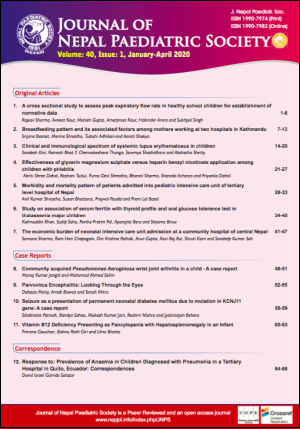Morbidity and Mortality Pattern of Patients Admitted into Paediatric Intensive Care Unit of Tertiary Level Hospital of Nepal
DOI:
https://doi.org/10.3126/jnps.v40i1.28853Keywords:
Children, Morbidity, Mortality, Nepal, PICUAbstract
Introduction: The paediatric intensive care unit (PICU) takes care of critically ill paediatric patients. Regular evaluation of the outcomes of patients admitted to PICU is important to assess the effectiveness of various interventions. This study aimed to find the morbidity and mortality pattern of patients admitted to PICU of tertiary level Paediatric hospital of Nepal.
Methods: We conducted a retrospective, cross sectional observational study using the records of all the patients admitted to PICU of a tertiary level hospital from January 2017 to August 2017. We collected data on age, sex, geographical distribution, duration of PICU stay and the morbidity and mortality outcomes. Outcome is classified as transfer to ward, leave against medical advice (LAMA) and death. Data were analysed descriptively using SPSS version 23.
Results: Out of 358 patients admitted to PICU, the mean age was 1.83 years. Majority were infants (54.5%) with male:female ratio of 1.8:1. The major causes of PICU admission were respiratory disease (27.7%) followed by CNS disease (19.6%) and infections (17.3%). The average length of stay was 6.27 days. Overall mortality was 22.7%.
Conclusion: Respiratory infections were the primary cause of PICU admission and overall mortality rate was high at 22.7%. However, mortality rate was even worse for patients with multi-system involvement. We need prospective studies to examine the underlying reasons for mortality among patients with multi-system involvement.
Downloads
Downloads
Published
How to Cite
Issue
Section
License
Authors who publish with this journal agree to the following terms:
Authors retain copyright and grant the journal right of first publication with the work simultaneously licensed under a Creative Commons Attribution License that allows others to share the work with an acknowledgement of the work's authorship and initial publication in this journal.
Authors are able to enter into separate, additional contractual arrangements for the non-exclusive distribution of the journal's published version of the work (e.g., post it to an institutional repository or publish it in a book), with an acknowledgement of its initial publication in this journal.
Authors are permitted and encouraged to post their work online (e.g., in institutional repositories or on their website) prior to and during the submission process, as it can lead to productive exchanges, as well as earlier and greater citation of published work (See The Effect of Open Access).



